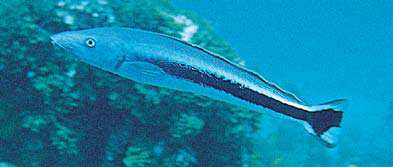MALACANTHIDAE
Sand Tilefishes and Blanquillos
By Ukkrit Satapoomin
 Hoplolatilus luteus |
 Malacanthus latovittatus |
|
Small to medium size fishes (15-38 cm); body elongate, fusiform or nearly cylindrical, with blunt or round snout. No predorsal ridge. Preopercle serrate (Hoplolatilus) or smooth (Malacanthus); and enlarged spine at angle of preopercle (Hoplolatilus), or spine absent (Malacanthus); opercle with single sharp pointed spine. Mouth terminal to slightly inferior, jaws slightly oblique; jaws each side with 4-6 mandibular pores. Dorsal and anal fins long and continuous; dorsal-fin spines III-XI in Hoplolatilus and I-IV in Malacanthus; dorsal-fin rays13-34 (Hoplolatilus) or 37-55 (Malacanthus); anal-fin spines I or II; anal-fin ray 12-20 in Hoplolatilus, and 37-55 in Malacanthus; caudal fin truncate or falcate with rounded or pointed lobes. Color: variable among species, yellow, olive brown to brilliant blue, or with longitudinal band or irregular stripe on side of body; head and fins with various color markings. Similar families occurring in the area. Pinguipedidae: always I anal-fin spine; soft portion of dorsal fin clearly higher than the spinous; eyes often jutting slightly above dorsal profile of head. Sillaginidae: two separate dorsal fins; ground color of body typically silvery. Remarks. Bottom dwelling fishes, found in shallow coral reefs, near edge of the reefs or over rubble or sandy bottom to the depth of 35 m. Feed mainly on benthic invertebrates such as mollusks, polychaetes, shrimps and small crabs. |

|
|